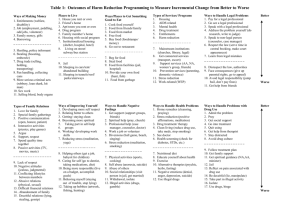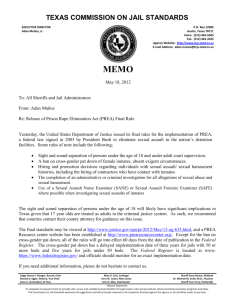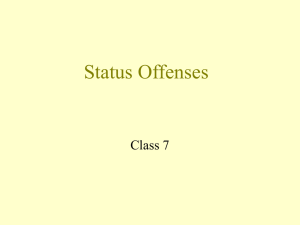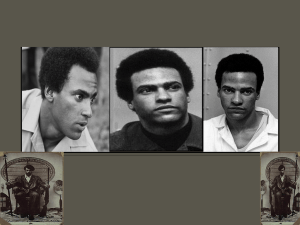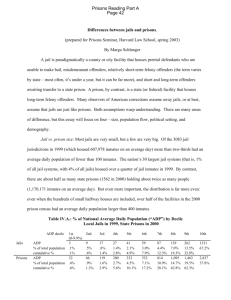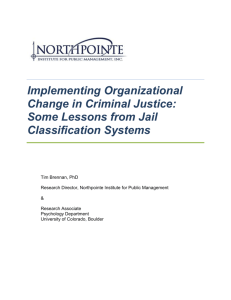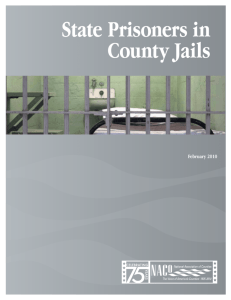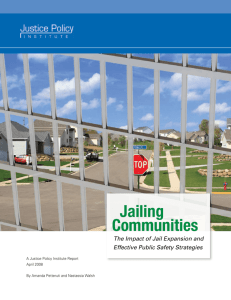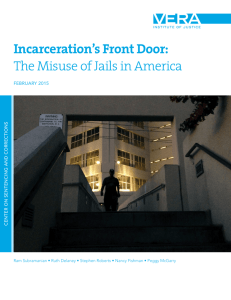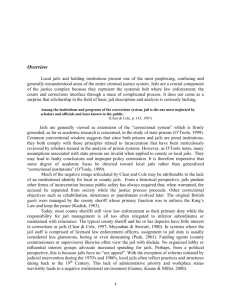fact sheet: jail removal and sight and sound core protections
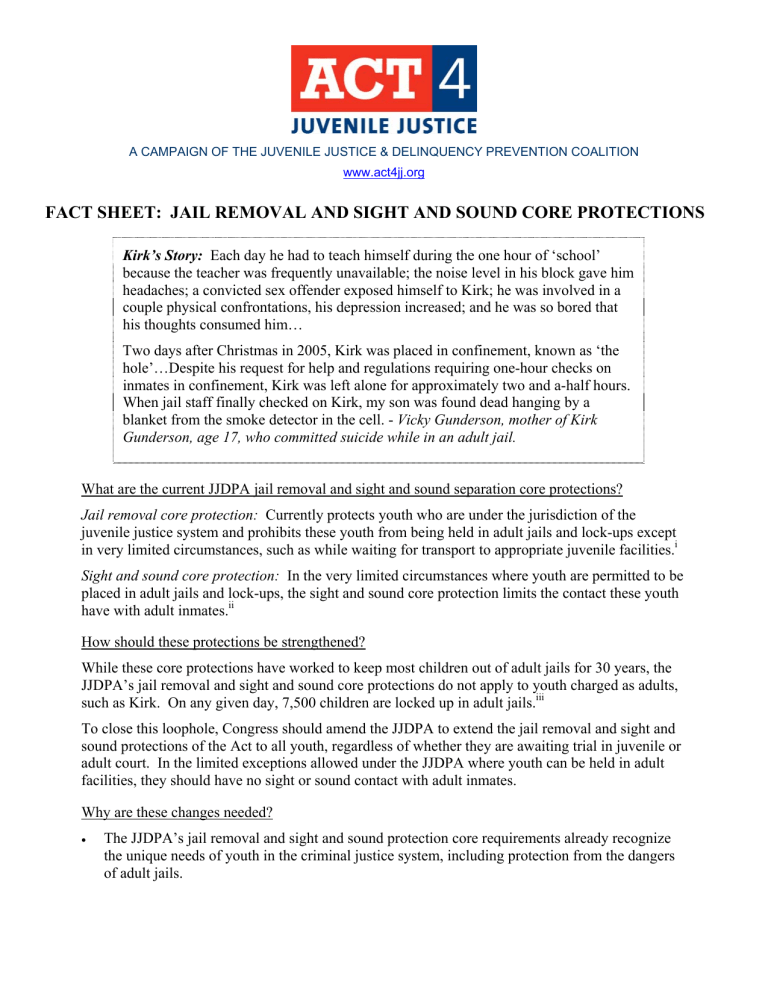
A CAMPAIGN OF THE JUVENILE JUSTICE & DELINQUENCY PREVENTION COALITION www.act4jj.org
FACT SHEET: JAIL REMOVAL AND SIGHT AND SOUND CORE PROTECTIONS
Kirk’s Story: Each day he had to teach himself during the one hour of ‘school’
because the teacher was frequently unavailable; the noise level in his block gave him
headaches; a convicted sex offender exposed himself to Kirk; he was involved in a
couple physical confrontations, his depression increased; and he was so bored that
his thoughts consumed him…
Two days after Christmas in 2005, Kirk was placed in confinement, known as ‘the
hole’…Despite his request for help and regulations requiring one-hour checks on
inmates in confinement, Kirk was left alone for approximately two and a-half hours.
When jail staff finally checked on Kirk, my son was found dead hanging by a
blanket from the smoke detector in the cell. - Vicky Gunderson, mother of Kirk
Gunderson, age 17, who committed suicide while in an adult jail.
What are the current JJDPA jail removal and sight and sound separation core protections?
Jail removal core protection: Currently protects youth who are under the jurisdiction of the juvenile justice system and prohibits these youth from being held in adult jails and lock-ups except in very limited circumstances, such as while waiting for transport to appropriate juvenile facilities.
i
Sight and sound core protection: In the very limited circumstances where youth are permitted to be placed in adult jails and lock-ups, the sight and sound core protection limits the contact these youth have with adult inmates.
ii
How should these protections be strengthened?
While these core protections have worked to keep most children out of adult jails for 30 years, the
JJDPA’s jail removal and sight and sound core protections do not apply to youth charged as adults, such as Kirk. On any given day, 7,500 children are locked up in adult jails.
iii
To close this loophole, Congress should amend the JJDPA to extend the jail removal and sight and sound protections of the Act to all youth, regardless of whether they are awaiting trial in juvenile or adult court. In the limited exceptions allowed under the JJDPA where youth can be held in adult facilities, they should have no sight or sound contact with adult inmates.
Why are these changes needed?
• The JJDPA’s jail removal and sight and sound protection core requirements already recognize the unique needs of youth in the criminal justice system, including protection from the dangers of adult jails.
•
•
Placing youth in adult jails has dire consequences:
Youth placed in adult jails are at great risk of sexual and physical assault . According to the U.S. Department of Justice Bureau of Justice Statistics, in 2005 and 2006, 21 percent and
13 percent (respectively) of the victims of inmate-on-inmate sexual violence in jails were youth under 18, despite the fact that only one percent of all jail inmates are juveniles.
iv
Youth have the highest suicide rates of all inmates in jails. Youth are 19 times more likely to commit suicide in jail than youth in the general population and 36 times more likely to commit suicide in an adult jail than in a juvenile detention facility.
v
Adult jails do not offer age-appropriate services for youth, such as access to education.
The most recent survey of educational programs in adult jails found that 40 percent of jails provided no educational services at all, only 11 percent provided special education services, and just 7 percent provided vocational training.
vi
Many children held in adult jails are transferred back to juvenile court or have their cases dismissed.
vii
Yet, their experience in adult jail has long lasting negative consequences.
Recent reports released by the U.S. Centers for Disease Control and Prevention (CDC) and the Office of Juvenile Justice and Delinquency Prevention confirm that trying youth as adults harms public safety .
viii
According to the report released by the CDC, youth who have been prosecuted as adults are, on average, 34 percent more likely to commit crimes than youth retained in the juvenile justice system.
Nationwide polling supports jail removal : According to a 2007 nationwide poll commissioned by the National Council on Crime and Delinquency, 89 percent of Americans believe that rehabilitative services and treatment for incarcerated youth can help prevent future crime. Youth who are detained in the juvenile system are more likely to receive the rehabilitative services necessary to help them turn their lives around.
ix
Case studies:
• In 2005, the Daily Progress newspaper in Charlottesville, VA reported that a 15-year-old boy was put into adult jail awaiting trial. The youth was placed in the same cell as a man convicted of the sex-based offense of “carnal knowledge of a minor” and witnessed a suicide attempt by another inmate who suffered head injuries after jumping from the second-tier of the facility.
x
• In 2007, the Pittsburgh-Post Gazette reported that in Pittsburgh youth aged 15 and older charged with nonfatal offenses whose parents can’t afford bail languish in adult jail from 12-18 months awaiting hearings on their adult status. One 17-year-old youth was jailed on charges of robbery with an unloaded gun and spent 17 months in an adult jail before a judge determined that his case should be heard in juvenile court.
xi i
42 U.S.C. 5633(a)(13) ii
42 U.S.C. 5633(a)(13)(A) and (B) iii
Jailing Juveniles: The Dangers of Incarcerating Youth in Adult Jails in America , Campaign for Youth Justice, p. 4, available at http://www.campaign4youthjustice.com/Downloads/NationalReportsArticles/CFYJ-Jailing_Juveniles_Report_2007-11-15.pdf
. (November 2007) iv
Id. v
Id.
at p. 10. vi
Harlow, Caroline Wolf, Education and Correctional Populations , U.S. Department of Justice, Office of Justice Programs, Bureau of Justice Statistics Special
Report, Table 3 on p. 4, available at http://www.ojp.gov/bjs/pub/pdf/ecp.pdf
. (January 2003) vii
Jailing Juveniles , p. 4. viii
Centers for Disease Control and Prevention, “Task Force Recommends Against Policies and Laws Facilitating Transfer of Youth to the Adult Justice System to Reduce Violence among Transferred Youth,” Guide to Community Preventive Services, available at http://www.cdc.gov/mmwr/pdf/rr/rr5609.pdf
. (April 13,
2007) and Richard Redding, Office of Justice Programs, OJJDP Juvenile Justice Bulletin, “Juvenile Transfer Laws: An Effective Deterrent to Delinquency?,” available at http://www.ncjrs.gov/pdffiles1/ojjdp/220595.pdf
. (August 2008) ix
Krisberg, Barry and Marchionna, Susan, Attitudes of US Voters toward Youth Crime and the Justice System Council on Crime and Delinquency , National
Council on Crime and Delinquency, p. 1, available at http://www.nccd-crc.org/nccd/pubs/zogby_feb07.pdf
. (February 2007) x xi
Rowe, Megan, “Video Case Sent to Juvenile Court: Rehabilitation Recommended,” The Daily Progress. (December 29, 2005)
Banks, Gabrielle, “Juveniles Languish in Adult Jails: Many Youths Spend Months in Prison Awaiting Legal Decisions,” Pittsburg Post Gazette. (November
19, 2007)


